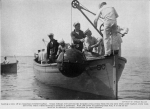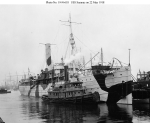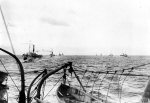NavSource Online:
Section Patrol Craft Photo Archive
Saranac (ID 1702)
King - Nan - Watch - Tare
Specifications:
| Click on thumbnail for full size image |
Size | Image Description | Source | |
|---|---|---|---|---|
| SS Hamilton | ||||
 |
156k | Post card, postmarked 6 September 1909, Fortress Monroe, VA | Tommy Trampp | |
 |
273k | Post card, postmarked 18 July 1910, New York, NY | ||
| USS Saranac (ID 1702) | ||||
 |
154k | . | Tommy Trampp | |
 |
120k | At the New York Navy Yard on 22 May 1918 after being painted in pattern camouflage. The civilian 88-foot tug Henry Gillen (1917) is alongside National Archives photo 19-N-618 from Shipscribe.com |
Robert Hurst | |
 |
71k | U.S. Navy minelayers proceeding to sea in two columns, in Area Number 2 of the North Sea, September 1918. Ships in the column at left are (from front to rear): Roanoke, Housatonic, Quinnebaug and Baltimore. Ships in column at right are (from front to rear): Canonicus (out of picture, to right), Canandaigua, Aroostook and Saranac. Note disruptive "dazzle" camouflage worn by these ships. Photograph from the Army Signal Corps Collection in the U.S. National Archives. U. S. Army Signal Corps Photo 111-SC-43563 |
Naval Historical Center | |
 |
111k | American minelayers underway on 20 September 1918. They include; on the right: USS Roanoke (ID-1695), USS Housatonic (ID-1697), USS Quinniberg (ID-1687), USS Baltimore (CM-1). On the left: USS Canonicus (ID-1696), USS Canandaigua (ID-1694), USS Aroostock (CM-3), USS Saranac (ID-1702) Imperial War Museum photo No.© IWM(Q 20254) from American First World War Official Exchange Collection | Mike Green | |
| Commanding Officers | ||
| 01 | CDR Sinclair Gannon, USN - USNA Class of 1900 Awarded the Navy Distinguished Service Medal - Retired as Rear Admiral | 9 April 1918 - 19 March 1919 |
|
|
Her conversion delayed by material shortages and labor problems, Saranac completed training and fitting out in May and June. On 16 June, she sailed for Scotland to participate in the laying of a proposed mine barrage between the Orkneys and Norway to close that avenue to the Atlantic and limit German U-boat activity to the North Sea. She arrived at Inverness on the 29th; and, on 14 July, headed for the minefield to plant 597 mines. Before the end of the month, she had completed a second excursion which brought her total to 1,177. During August, breakdowns in her mining apparatus and engineering plant precluded mining activities, but, in early September, she returned to the fields. On the 7th, she planted 600 mines and on the 20th added another 600.
On her third excursion into the barrage area during that month, 26 through 28 September, Saranac suffered her only loss of World War I. G.C. Anderson, BMC, went overboard when the inhaul wire of the port paravane parted on the afternoon of the 27th. All efforts to recover him were unsuccessful.
Between then and 26 October, when she planted her last mine, Saranac completed four excursions to the fields and laid another 2,445 mines. On 11 November she received word of the Armistice and soon thereafter prepared to return home. At the end of the month, she departed Inverness for Scapa Flow where her crew saw the surrendered German ships. On 8 December she began to make her way back to the United States. Steaming via English and Portuguese ports, she arrived in Hampton Roads, Va., on 3 January 1919, and later in the month moved up to the Philadelphia Navy Yard. There, on 19 March 1919, she was decommissioned and delivered to the United States Shipping Board for return to her owner.
| Back to the Main Photo Index | Back to the Identification Numbered Vessel (ID) Photo Index | Back to the Mine Warfare Ship Photo Index | Back To The Minelayer (CM) Photo Index |
| Comments, Suggestions, E-mail Webmaster |
|
This page created by Joseph M. Radigan and maintained by David Wright |